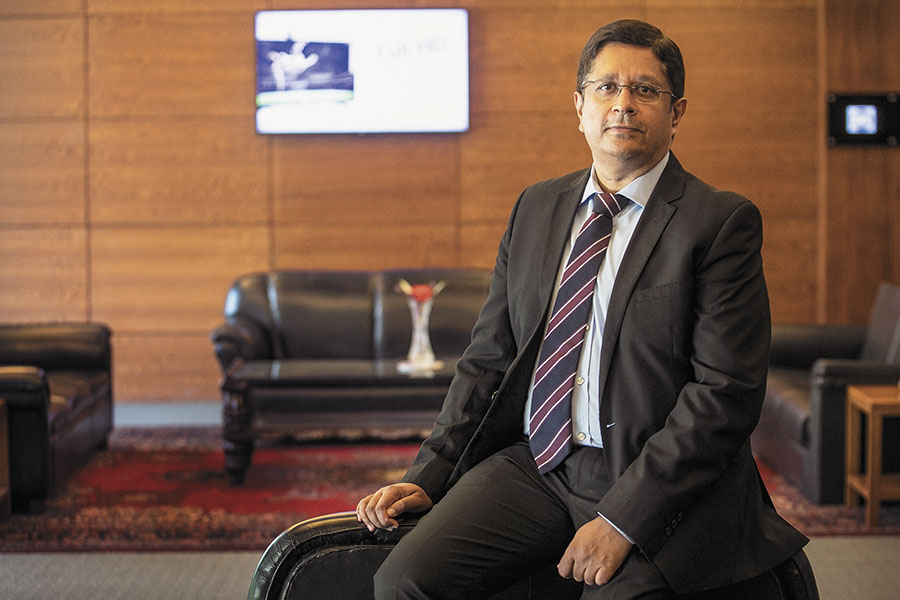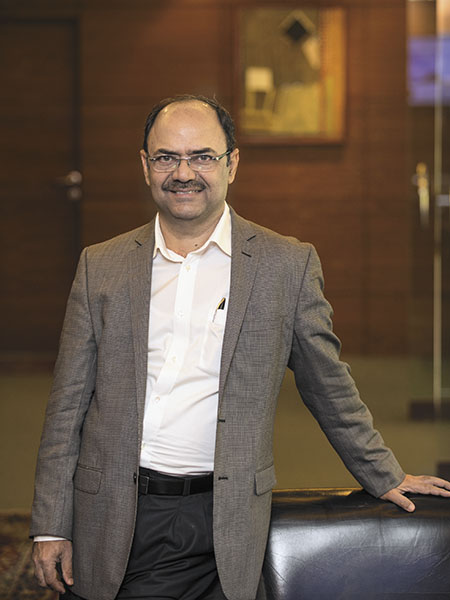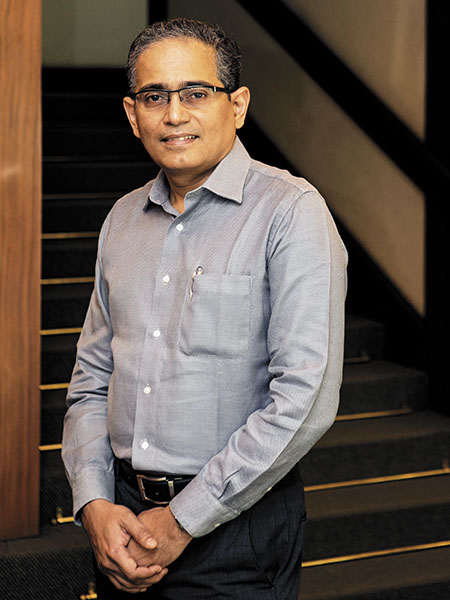
Consumer electronics giant BPL is plotting a quiet revival
A tremor in Japan, the onslaught of foreign brands in India, and a discord within the Nambiar family knocked down consumer electronics giant BPL. Now, scion Ajit Nambiar is planning a comeback
 Resurrecting a giant: Ajit Nambiar, chairman and managing director, BPL Ltd
Resurrecting a giant: Ajit Nambiar, chairman and managing director, BPL Ltd
Image: Selvaprakash Lakshmanan for Forbes India
LifePhone+, a health and fitness monitoring device manufactured by BPL Medical Technologies, is just about the size and weight of a smartphone. Its uses range from monitoring cardiovascular health to recording blood sugar levels. A companion smartphone app, also built by the company, stores the medical records on the cloud, enabling a panel of doctors to keep round-the-clock watch on patients and arrange for medical aid if required.
The instrument is one of a carefully chosen, tightly integrated set of medical devices that Ajit Nambiar, chairman and managing director of BPL Ltd, is betting on to resurrect the glory of his family business, started by father TP Gopalan Nambiar, or TPG as he is popularly known.
Those old enough to have memories of life in the 1990s can quickly recall the brand name BPL. Most middle-class homes had at least one BPL consumer device—a television set, a stereo or a refrigerator—that the company built in partnership with Japan’s Sanyo Electric.
Once among India’s largest consumer electronics players, BPL started life as a small supplier of precision panels to the armed forces in 1963 from Kerala’s Palakkad district. Over the next few decades, the group diversified into medical devices, consumer electronics and eventually telecom.
At its peak, in the late ’90s, TPG presided over a group that garnered annual revenues of Rs 4,300 crore, owned 25 factories in India and abroad, and was selling over a million colour television sets every year, and even exporting to Europe.
In 1999, TPG passed on the baton to Ajit Nambiar, who took over as chairman and managing director of BPL Limited.
The deluge began in 2004 when an earthquake destroyed Sanyo’s semiconductor plant in Japan, severely crippling its business. The financial tremors were felt in India too, and the company’s joint venture with BPL was wound up in 2007.
Without its technology partner, BPL was left to fend for itself amid the onslaught of South Korean giants Samsung Electronics and LG Electronics, which had found their feet in India in its decade-and-a-half of economic liberalisation. Rapidly losing market share to foreign rivals, BPL was forced to sell off many of its factories.
“My darkest hour was when dealers were asking for BPL products because there was still a demand for them, and we couldn’t supply,” says Nambiar.
But despite the troubles, some of the units within the business kept going, including an electronics components business, and a printed circuit board operation that remained modestly profitable.
Adding to these external shocks, a discord was brewing within the Nambiar household: A legal dispute between patriarch TPG and son-in-law Rajeev Chandrasekhar over the ownership of BPL Communications arose. The telecom unit was the brainchild of Chandrasekhar, who was widely seen as the force that built the BPL Mobile brand.
The matter was eventually settled out of court in 2005, with Chandrasekhar buying out TPG’s stake (roughly 8 percent, according to media reports) in the telecom business. He sold the business to the Essar Group the same year for about $1.1 billion, and started the investment firm Jupiter Capital. (Chandrasekhar is currently also a Rajya Sabha MP from Karnataka.)
The BPL group is today a mere shadow of its former self: For FY2016, it posted a loss of Rs 8.44 crore on a standalone basis. For the quarter ended December 31, the company had a modest profit of Rs 20.25 lakh.
Nambiar is now trying to raise the flag of his family business once again, with the medical technology unit leading the charge. (Although Goldman Sachs owns a majority share in BPL Medical Technologies, it remains part of the BPL group.)
He is also shepherding a strategy that, he hopes, will see BPL’s consumer goods—washing machines, refrigerators and TVs—return to Indian homes. Thousands of BPL’s new line of LED televisions were sold during ecommerce major Flipkart’s annual Big Billion Day sale last October.
For this interview, the 53-year-old Nambiar seats himself in the company’s modest conference room at Dynamic House in Bengaluru. The property serves as an office for the family members; BPL’s corporate office, a swanky 80,000 square feet facility, is a 30-minute drive away.

Man at the helm: Sunil Khurana, CEO and managing director at BPL Medical Technologies
Image: Selvaprakash Lakshmanan for Forbes India
At Dynamic House, Nambiar is flanked by Sunil Khurana, CEO and managing director of BPL Medical Technologies, and Manmohan Ganesh, a BPL veteran who has worn many a hat at the company through thick and thin, and is currently CEO of PRO FX, BPL’s high-end audio equipment unit—one that is close to Nambiar’s heart. (The company also has units that manufacture lighting equipment, landline phones, devices for home surveillance and automation.)
Entering the conference room, you could almost miss a small assortment of photographs that capture some of the milestones in the company’s history. In one of them, TPG is seen signing an agreement with one of the original owners of British Physical Laboratories, a British family by the name of Sheridan.
Born and raised in an agricultural village in Kerala, young TPG sailed to Britain, where he did odd jobs and managed to study in the 1950s. Armed with a specialisation in air conditioning and compressor technology, he went on to land a job with American Standard. The company sent him back to India to sell their large systems used in centralised air conditioning, and “the first unit he sold was to Oberoi hotel in Delhi”, Nambiar recalls about his father.
It wasn’t long before TPG, now 88 and no longer involved in the day-to-day business, found the entrepreneurial opportunity he was always seeking. He started to manufacture panel meters for British Physical Laboratories and ended up acquiring their company. Thus was born BPL.
Like his father, Ajit Nambiar too studied abroad. After studying engineering at Boston University, he joined the family business in 1984. “I was trying to do an MBA, but my dad said I’d get a better education if I work at BPL… he was probably worried I’d settle in the US,” Nambiar quips. He was initially sent to Japan for training at Sanyo so that he could bring their technology to BPL.
Meanwhile, TPG roped in his brother-in-law KPR Nambiar to lead the manufacturing part of the business from the Palakkad plant, while he oversaw the overall business from Bengaluru. KPR Nambiar’s two sons also had stints at BPL—one as director of R&D and another in operations—but they are no longer with BPL.
With a penchant for Japanese tie-ups, the Nambiars brought in technology from Fukuda Electric to start making ECG machines in 1967, and from Nihon Kohden to start making patient-monitoring systems in 1972, beginning the diversification into the medical equipment business.
The move towards consumer electronics came in 1982, when the Asian Games was hosted in Delhi, spurring a demand for television sets. This inspired TPG to venture into the manufacture of colour televisions, riding on the close partnership that BPL had fostered with Sanyo.
Consumer electronics was the company’s milch cow till the turn of the century. But in the years leading up to 2007, when the Sanyo JV collapsed, competition from foreign players Samsung and LG intensified, and BPL started ceding market share.
“Manufacturing electronics in India has always been a challenge, partly because of policy and tariff-related problems,” says Rishikesha T Krishnan, director of Indian Institute of Management, Indore, and a professor of corporate strategy. “Despite our large domestic market, we have not been able to create strong local brands that can hold their own against Korean big weights like LG or Samsung. Indian companies haven’t been able to take advantage of economic liberalisation to the extent they ought to have.”
He points out that had things turned out differently, BPL could have been a major player even internationally.

Making new music: Manmohan Ganesh, CEO, PRO FX
Image: Selvaprakash Lakshmanan for Forbes India
In 2013, Goldman Sachs, for about Rs 110 crore, acquired a 49 percent stake in BPL Medical Technologies, which was spun off into a separate entity within the group around 2012. Goldman Sachs currently owns close to two-thirds of the business. Khurana, 55, with close to three decades of experience in the field, mostly with GE Healthcare, was named CEO of the medical business around the same time, and in the last three years the unit has grown to a point where it is leading BPL’s revival.
In September 2015, BPL Medical Technologies acquired Penlon, a maker of anaesthesia machines in Britain, getting access to products and an extensive network of potential overseas customers for BPL’s future products, such as the LifePhone+. In India, the acquisition has made BPL a leader in anaesthesia machines.
Khurana has also led the company’s partnerships with other technology specialists, such as Ambu in Denmark to make and sell video laryngoscopes, as well as consumables such as mannequins used in medical colleges. South Korea’s Alpinion Medical Systems supplies the technology for the imaging systems.
Three years ago, the medical business did about Rs 70 crore in annual sales. In the current fiscal, it has crossed Rs 300 crore, says Khurana, projecting sales to rise to Rs 1,000 crore by 2021. He aspires to make the business the “largest Indian medical equipment company”, which will need an additional Rs 1,500 crore in sales.
An important part of the strategy to get there is a new consumer medical division taking shape, which will tap the large existing market for devices and consumables in hospitals. BPL won’t go after all of those, but will selectively look to build market share in products that tie in with it the technology it’s building.
In addition to the sale of hi-tech medical devices like the LifePhone+, there is the cloud-based subscription revenue that it brings in, for which it has partnered with IT services provider Tech Mahindra.
“ Manufacturing electronics in India has always been a challenge.
“There is a lot of innovation in it, and it’s made in Bengaluru,” says Nambiar. Khurana adds: “I think this [LifePhone+] is a product that is at least three to four years ahead of its time.” He also points out: “We are now visible everywhere, and visibility has its benefits. We showcase all our new technologies and products. People are looking at this cutting-edge technology coming into BPL. Showcasing the ability to manufacture and sell these products has a rub-off effect on the brand, and the overall corporate image of BPL.”
With the medical technology business finding its groove, Nambiar has turned his attention to reviving the consumer electronics unit that currently sells only through Flipkart. If he is hoping the unit gets to do something similar to BPL Medical, he is strictly keeping those aspirations to himself. Nambiar is clear that the initial success of the company’s very small range of televisions on Flipkart is just the beginning. However, he is planning to release smart televisions as well.
“Our best sellers are still the 32-inch and 40-inch sets, but the smart technologies will be released soon,” he says, not revealing any specifics. “We have something up our sleeve that will make the smart smarter and the television experience better.” The excitement, however well-contained, is palpable, and he can’t resist adding: “It’s software related, and partly to do with enhancing the sound experience. There is a lot of engineering going on there, it should be coming out by the end of the year.”
The business is still small. It’s early days and “it’s a crowded market,” says PVG Menon, founder and CEO of Vann Consulting, a consultancy in the area of electronics and related government policy.
“The customers who know the BPL brand are the wrong demography—how many people who have already set up a home will buy any new products? And the younger lot does not know what BPL stands for. The challenge is going to be building the brand,” says Menon, who has also served as president of the India Electronics & Semiconductor Association, an industry lobby. “BPL doesn’t have an issue with system design. The issue is going to be with building the brand.”
And until the brand image is resurrected, sales won’t climb. Among the categories of products that BPL sells on Flipkart, “we are at 10 percent of their [television] business,” says Nambiar. However, he is aware that although Flipkart has about a 55 percent share of the online retail segment, the total ecommerce sector in India—defined as products and services ordered via the internet, but excluding travel and event ticketing—is only about 2.5 percent of the country’s total retail. That means, BPL’s televisions have merely begun to get customer attention, compared with the 21 percent market it had in its heydays.
That said, “We’re catching up very fast. We’ve gone from zero to where we are today very fast. And the plan is to double it and triple it,” says Nambiar. Starting with one 32-inch television, BPL now has three more larger models that will soon be introduced. Washing machines are being made as well.
Through all the turmoil following the collapse of the Sanyo JV, right up to a couple of years ago when people—especially old-timers who had moved to other companies—started getting wind of a quiet revival, there has been one thing that has made an important difference, Nambiar says. “We never stopped activity, we kept innovating; we never stopped.”
A lot of financial re-engineering and re-grouping had to be endured. “My team, or I, never stopped thinking of products and technology. We kept developing things hoping that one day … [they would hit the market].” Ganesh adds: “We may have had to sell factories and so on, but we never got rid of R&D.”
And then, there is tremendous loyalty from many old-timers, Ganesh adds. “Last year, we had a get together… people were coming on stage and saying, ‘I’m working somewhere else, but I’ll come help you during weekends’.”
Maybe it is the same sense of belonging that keeps Nambiar’s sister Anju Chandrasekhar (49) still tied to the company. She remains a director on the board of BPL and continues to advise and support her brother, long after her father’s fall-out with her husband. Her children are not involved in BPL, neither is Nambiar’s daughter Shreya (23), who works for Ujjivan Financial Services.
Nambiar may have once fantasised about a longer stay in the US, but there’s no mistaking the desire to do something with BPL that his father will be proud of: “Even today, if you talk to my dad, he’ll say ‘do something that people need in this country’,” he says. This natural inclination to serve is perhaps what keeps BPL going despite all the trials.
(This story appears in the 31 March, 2017 issue of Forbes India. To visit our Archives, click here.)















